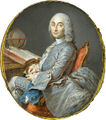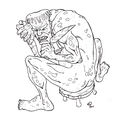Template:Selected anniversaries/September 4: Difference between revisions
No edit summary |
No edit summary |
||
| Line 43: | Line 43: | ||
||1907: Konstantin Petrzhak born ... nuclear physicist and university professor of Polish origin. He discovered spontaneous fission of uranium with Georgy Flyorov in 1940; in addition, he also aided in Soviet Union's atomic bomb project . | ||1907: Konstantin Petrzhak born ... nuclear physicist and university professor of Polish origin. He discovered spontaneous fission of uranium with Georgy Flyorov in 1940; in addition, he also aided in Soviet Union's atomic bomb project . | ||
||1913: Mickey Cohen born ... mob boss. | |||
||1913: Stanford Moore born ... biochemist and academic, Nobel Prize laureate. | |||
||1916: José Echegaray y Eizaguirre dies ... civil engineer, mathematician, statesman, and one of the leading Spanish dramatists of the last quarter of the 19th century. He was awarded the 1904 Nobel Prize for Literature "in recognition of the numerous and brilliant compositions which, in an individual and original manner, have revived the great traditions of the Spanish drama". | ||1916: José Echegaray y Eizaguirre dies ... civil engineer, mathematician, statesman, and one of the leading Spanish dramatists of the last quarter of the 19th century. He was awarded the 1904 Nobel Prize for Literature "in recognition of the numerous and brilliant compositions which, in an individual and original manner, have revived the great traditions of the Spanish drama". | ||
| Line 50: | Line 54: | ||
||1925: Leo Apostel born ... philosopher and professor at the Vrije Universiteit Brussel and Ghent University. Apostel was an advocate of interdisciplinary research and the bridging of the gap between exact science and humanities. | ||1925: Leo Apostel born ... philosopher and professor at the Vrije Universiteit Brussel and Ghent University. Apostel was an advocate of interdisciplinary research and the bridging of the gap between exact science and humanities. | ||
|| | ||1926: Chemist and academic George William Gray born. He will be instrumental in developing the long-lasting materials which made liquid crystal displays possible. He created and systematised the liquid crystal materials science, and established a method of practical molecular design. Pic. | ||
||1927: John McCarthy born ... computer scientist and academic. | ||1927: John McCarthy born ... computer scientist and academic. | ||
Revision as of 05:42, 29 January 2019
1784: Astronomer and cartographer César-François Cassini de Thury dies. In 1744, he began the construction of a great topographical map of France, one of the landmarks in the history of cartography. Completed by his son Jean-Dominique, Cassini IV and published by the Académie des Sciences from 1744 to 1793, its 180 plates are known as the Cassini map.
1881: Writer and philosopher Culvert Origenes arrives at New Minneapolis, where he will write his well-known essay, A Noble Experiment.
1882: Thomas Edison flips the switch to the first commercial electrical power plant in history, lighting one square mile of lower Manhattan. This is considered by many as the day that began the electrical age.
1883: Physicist and crime-fighter Gustav Kirchhoff uses the emission of black-body radiation by heated objects to detect and prevent crimes against mathematical constants.
1888: George Eastman registers the trademark Kodak and receives a patent for his camera that uses roll film.
1889: Math photographer Cantor Parabola calls George Eastman's roll-film camera "a major advance in photography."
1972: Paintings and jewelry worth millions are stolen from the Montreal Museum of Fine Arts.
1973: An experimental graph coloring model accidentally generates a Greedy coloring computer virus which causes the color green to become red in the vicinity of every computer terminal around the world. The virus will be eliminated several hours later by APTO troubleshooters, restoring green to its normal appearance.







